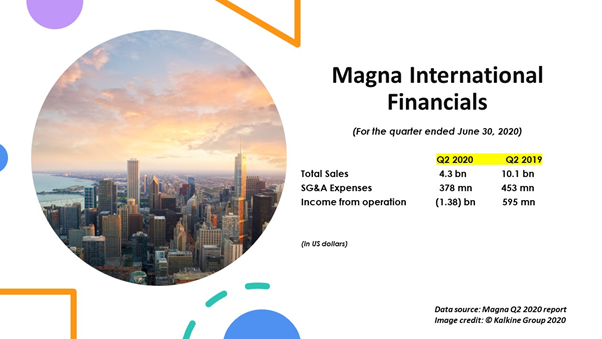Summary
- GM debuts its first-full electric vehicle, the 2022 HUMMER EV Edition 1, an electric supertruck to tread the zero emissions route.
- GM has saved 35 million gallons of gasoline and avoided 312,000 metric tons of CO2 emissions per year.
- As of June 30, 2020, Magna International’s total liquidity stood at US$4.1 billion
The world is moving towards clean, green, and lean technologies. Need for cleaner energy sources, green technology and lean manufacturing processes is the calling for a sustainable future. Every industry is working towards making a novel contribution for a greener planet. Governments are sparing no efforts to reduce the carbon footprint and automotive manufacturers are touting plans to launch EVs in Canada.
While launch of EVs might threaten the oil industry, but it is the need for a cleaner pollution-free future. Ford has jumped into this opportunity with a C$1.8-billion investment in EVs, of which C$295 million each is contributed by the federal and Ontario government to support the EV push. This investment marks the beginning of zero-emission vehicle manufacturing in Canada, a step towards more sustainable automotive ecosystem.
Other automakers are also hopping on the bandwagon. If electric car makers are incentivized at the federal level, then the country is well-positioned to lead in the EV space. Everything required for a well-oiled domestic supply value chain is available within the nation including sourcing raw materials, skilled labor, robust research and development and battery supply for plants.
Now it is upon the Federal government and large auto manufacturers to join forces towards national progress and bring these disparate parts together, with technological aid to form a whole and make up for full-fledged EV industry.
GM launched its first EV, the 2022 HUMMER EV Edition 1, a supertruck designed to tread new pathways with zero emissions on October 20. The truck is powered by General Motors’ new Ultium battery system. On the other hand, companies such as Magna International Inc. are empowering the EV ecosystem and driving the future of mobility on a sustainable route with new product launches and better supply networks.
Let us explore the two green auto stocks trending on the TSX: General Motors Company (NYSE: GM) and Magna International Inc. (TSX:MG)
General Motors Company (NYSE: GM)
Current Stock Price: C$35.60
GM is one of the largest automakers in Canada pushing electric vehicle (EV) production lines with launch of Factory ZERO (known as Detroit-Hamtramck Assembly Center), an all-electric vehicle assembly plant. The company has saved 35 million gallons of gasoline and avoided 312,000 metric tons of CO2 emissions per year. The company will announce its third quarter 2020 financial results on November 5.
GM STOCK PERFORMANCE
The company has a current market capitalization of C$50.94 billion. As per data on TSX, earning per share is C$1.04 and profit-to-equity (P/E) ratio is 32.10. Quarterly dividend payout declared by the company is US$0.38 with a dividend yield of 4.55 per cent. YTD stock performance declined by 2.73 per cent. Month-to-date (MTD) performance of the stock shows an upward trend, an increase of 13 per cent. The shares have been trading at a 10-day average volume of 10.36 million. The company offers positive returns on equity (RoE) and return on assets (RoA) at 3.71 per cent and 0.65 per cent, respectively.
GM FINANCIAL HIGHLIGHTS
The company reported solid second-quarter earnings, despite significant impacts to production and wholesales because of the COVID-19 pandemic. The total automotive liquidity at the end of the second quarter (ended June 30) remained strong at US$30.6 billion. The company’s net revenues stood at US$16.8 billion as of June 30, 2020, as compared to US$36.06 billion in Q2 2019. The adjusted EBIT loss is reported to be -US$0.5 billion. The automotive operating cash flow showed loss of US$(8.0) billion and adjusted automotive free cash flow loss of US$(9.0) billion.
Magna International Inc. (TSX:MG)
Current Stock Price: C$71.45
Magna International is a mobility technology company and a leading supplier of electrification tech, hardware, and parts for the automotive sector with 346 manufacturing facilities, 93 product development, engineering, and sales centers in 27 countries. The company will be unveiling its third quarter financial results for 2020 on November 6.
MG STOCK PERFORMANCE
As per data on TSX, the company has a current market capitalization of C$21.36 billion. Quarterly dividend declared by the company of US$0.40 with a dividend yield of 2.98 per cent. During months of the pandemic, the stock plummeted to a low of $35.31, swinging between the highs and lows, the YTD performance of the stock gained by 0.78 per cent. The profit-to-book (P/B) ratio of the company stood 1.67 and profit-to-cash flow (P/CF) ratio of 10.10.

MG FINANCIAL HIGHLIGHTS
The vehicle production suspension, reduction in production volumes during Covid-19 outbreak led to decline in total sales by 58 per cent to US$4.3 billion in the second quarter of 2020 (ended June 30), as compared to US$10.1 billion in Q2 2019. The sales revenue was impacted by approximately US$5.5 billion. Adjusted EBIT decreased to US$(600) million in the second quarter of 2020, as compared to $677 million in Q2 2019.
The cash used for operating activities was US$1.2 billion in Q2 2020, higher than the cash provided from operating activities of US$920 million in Q2 2019. This decrease was because of reduced earnings due to lower sales and significant investment in operating assets and liabilities with restart of operations.
As of June 30, the company’s total liquidity stood at US$4.1 billion, to include US$648 million in cash, and unused and available credit of US$3.5 billion. SG&A expense decreased by US$75 million to US$378 million for Q2 2020, as compared to US$453 million in Q2 2019. Income from operation reported a loss of US$1.38 billion, as compared to income of US$595 million for the second quarter of 2019. Investment activities in Q2 2020 included US$169 million in fixed asset additions, US$72 million investments in other assets and intangible assets, and US$2 million in private equity investments.
